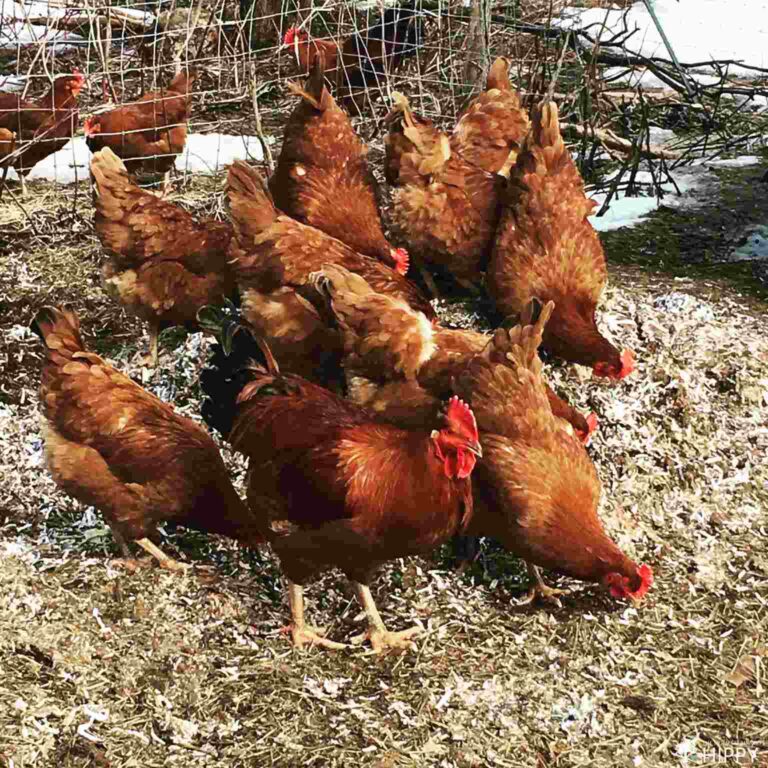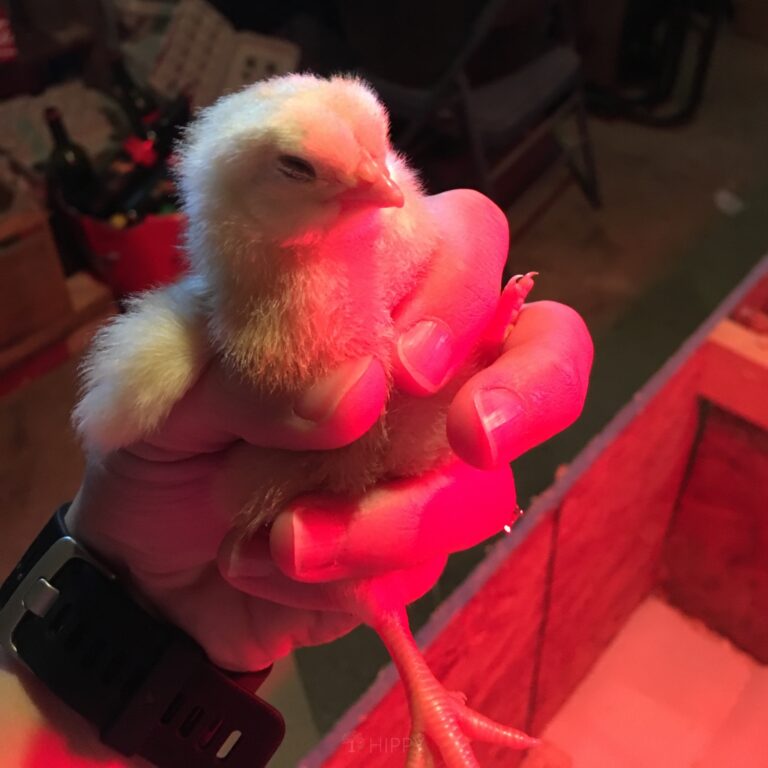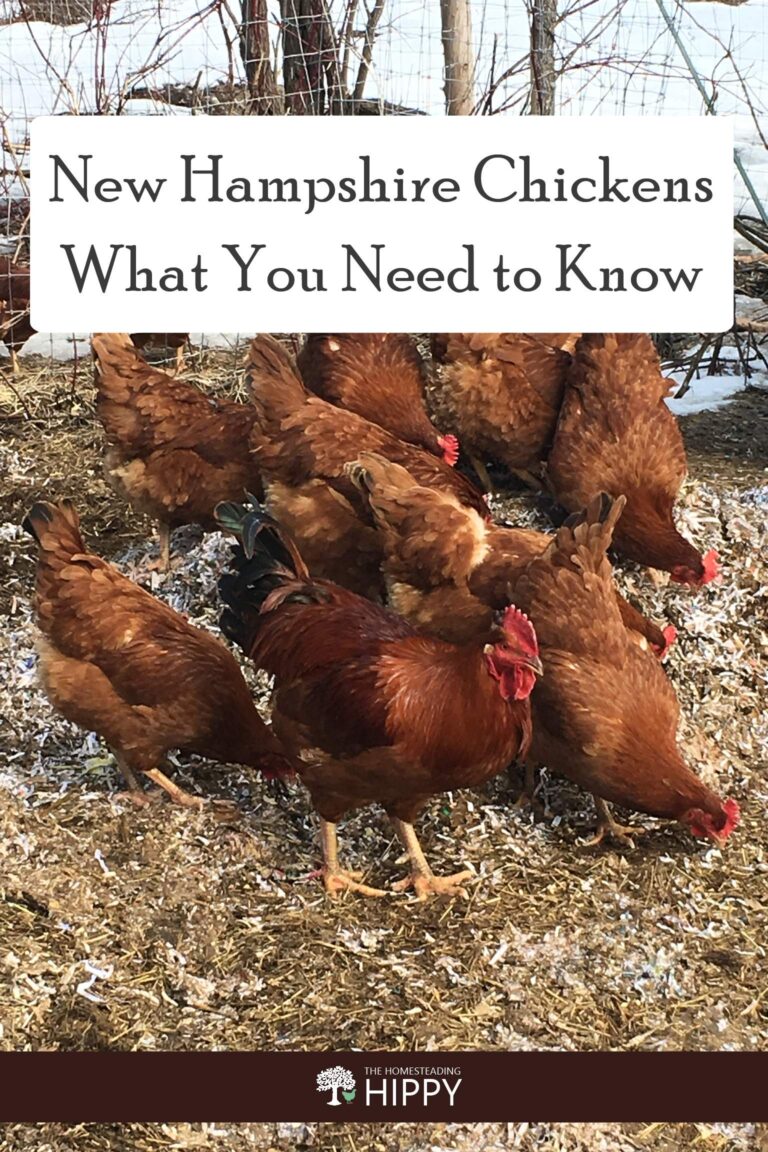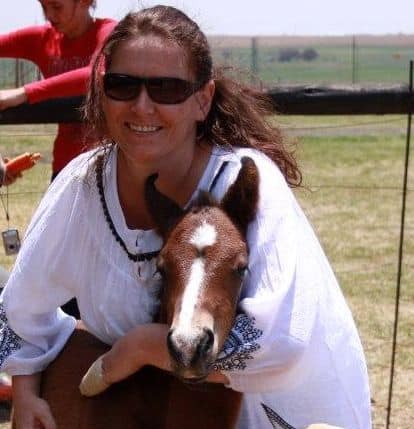Originating in America in 1910, professor ‘Red’ Richardson with input from local farmers and the New Hampshire Agricultural Experiment Station began the process of creating the New Hampshire hen.

This was in response to poultry breeders desire for hens that are fast feathering and chickens that grew and matured quicker than the Rhode Island Red breed of chickens.
It took 8 years to perfect the breed, but the result was well worth the effort. The new breed of New Hampshire Reds was admitted to the American Poultry Association in 1935.
Bred for eggs and meat, they were a popular source of food during war times. They became a valuable food source, making them the go to chicken for the poultry industry.
The New Hampshire breed are also a much-loved breed because of their friendliness as pets.
If you want to be a chicken keeper, this guide will tell you everything you need to know about the breed.
Table of Contents
Quick Overview
| Average rooster weight | 8.5 lbs. |
| Average hen weight | 6.5 lbs. |
| Comb type | Red, five-combed |
| Beak color | Reddish-brown or comb |
| Life expectancy | Around 8 years |
| They reach maturity in | 16 weeks |
| Broodiness | Moderate |
| Heat tolerance | Very good |
| Eggs laid per year | 500 |
Why You Should Raise New Hampshire Chickens
New Hampshire chickens are the perfect breed for a number of reasons.
They are a robust breed that are well known for meat production and eggs and are popular pets. They are gentle birds that are easy to keep and breed.
Because they are great forages, they can provide a valuable service to rid your yard of unwanted bugs that would feed on your plants.
They thrive in runs and free range. Their gentle natures ensure that there is not an abundance of aggression towards other birds or people.
Hens are great mothers who are known for taking care of their own chicks and strays, keeping them warm and safe.
They are not fazed by cold conditions. Their insulated feathers and bodies insulate them against cold conditions.
They will forage happily in the snow without a care in the world. They will need a ventilated, insulated coop with absorbent, poultry dust bedding to rest and relax.
They are also tolerant of warm climates. While they did not win, the breed entered contests like Chicken of Tomorrow in the late 1940’s, a popular trend in the period.
Why Raise New Hampshire Chickens
New Hampshire chickens are raised for eggs, meat, and as pets. The purpose of raising them will influence the environment you will need to give them.
I get heartbroken when I see how commercial farms are run, where chickens are put in tiny boxes, and never allowed to exercise. The only thing they can do is eat and drink from a bowl in front of them from a seated position.
If you are breeding for meat, the enclosure you are providing your chickens does not need to be very large. The coop should be 4 square feet per bird with a run of 10 to 11 square feet.
If you are keeping chickens for eggs, the nests should be 4 square feet per bird, but the run can be as big as you want or are able to give. The minimum space is still 10 to 11 square feet per bird.
Pets need a safe place to nest. New Hampshire chickens are super friendly and will happily follow you wherever you go.
I had a rooster named Bruster who would always wait for me at the gate when I was due home from school.
He took things to the extreme and would always sit (on a plate my horrible brothers would place) in the middle of the dinner table at mealtimes; he would happily look from person to person clucking along as part of the conversation. In three words: BEST PET EVER!
Characteristics
Behavioral Tendencies
Need Hampshire chickens are very docile. They are not generally aggressive towards people, but they can be food aggressive. They will force their way through the flock and push other birds away from the bowls.
It is better to make food available more often to ensure they are not starving at dinnertime as this could cause some pushing and shoving at the table.
More feeding stations will also reduce bullying. You should have one feeder for every 10 birds.
Appearance
New Hampshire chickens are one of the most (to my eyes the most) attractive chickens. Their pin feathers are a reddish buff color.
They have thick, fluffy plumage that ranges on color from golden bay to chestnut red, to golden red brown, to dark brown, to black, to red, to white, to blue-tailed red.
Their tail feathers normally have some black in them. Hens normally have black on the tips of some feathers on their necks.
New Hampshire chickens are considered medium to large. Roosters weigh approximately 8.5 pounds; hens weigh approximately 6.5 pounds.
They have red, five-pointed single combs. Because they are single combed, they are unfortunately prone to frostbite. Because of this, their coop is very important. It should be properly sheltered and moisture free.
They have long and oval shaped earlobes, and large wattles. Their beaks are either reddish brown or horn color. Their faces are red, and they have bay eyes. Their feet and legs are yellow with reddish brown overtones.
Lifespan
New Hampshire chickens live approximately 7 to 8 years, unless they are being raised for meat. They achieve early maturation at 16 weeks.
Broodiness
New Hampshire chickens are moderately broody. While they are not constantly broody, they make fantastic mothers.

They often treat bantams as chicks and can force bantams under their wings against their wishes. When they are broody, they can co parent with chicks from other hens if allowed.
They are very good mothers.
Heat Tolerance
New Hampshire chickens are exceptionally weather tolerant. Many breeds of chickens are good in either hot climates or in cold climates. New Hampshire chickens are good in both.
They do well in moderate to hot temperatures; they do need to have access to shade, cold, fresh water, and a well-ventilated coop.
Reproduction
New Hampshire chickens do lay unfertilized eggs if there is no rooster. Even if a rooster is present, not all eggs will necessarily be fertilized.
Hens lays unfertilized eggs every 24 hours. If paired with a rooster, New Hampshire chickens lay fertilized eggs that will hatch in 21 days.
Confinement
While New Hampshire chickens tolerate confinement, confinement is normally used for meat birds or mass egg production facilities. New Hampshire chickens prefer having free range.
They love to scratch in the dirt and forage for food; they are great foragers and as such they will lower your food bill if left to roam in a safe area.
Bedding
To create a healthy, comfortable roost for your birds, the bedding you choose is very important.
Hens spend a fair amount of time on their nests laying eggs, sitting on their eggs, caring for their chicks, and sleeping.
Bedding should be clean and dry; it should be able to absorb moisture and should be replaced when it becomes too wet.
Hay, straw, grass, wood shavings, and even shredded paper all work well – paper should be a last resort or just added to other bedding as it does not hold its structure well and can become soggy very easily.
Always provide 2 more nests than hens, New Hampshire chickens sometimes like a bit of privacy when sitting on eggs or raising their chicks.
What You Need to Get Started
Spend a little extra to buy good stock birds to start with.
Always buy from a reputable breeder rather than a back yard breeder. Back yard breeders often have illnesses on their property (often without knowing about the illnesses).
Your chickens will need access to clean, cool water 24 hours a day. You will need to provide ground level water bowls that are cleaned daily to remove bacterial and fungal growth.
Your New Hampshire chickens will need a diverse diet consisting of:
- protein in the form of insects, creepy crawlies
- liver, meat, or meat meal
- vegetable protein (some of which is found in commercial chicken food)
- carbohydrates found in grains
- fats (not too much as too much will result in digestive issues)
- calcium and small amounts of phosphorus, as well as salt are all important minerals needed for strong bones and healthy egg shells
- vitamins A, D, and B complex are all important to promote healthy growth.
If you want to make your own feed, it should include wheat, barley, corn, millet, rye, flax, grain by-products, either skimmed or butter milk, balancers and concentrates, and fish oil.
They will need safe nests in a coop or sheltered area. Even free-range chickens need safe housing. They need to be protected from predators in an enclosed area in the daytime, and a properly enclose coop at night.
I want to strongly encourage you to take health very seriously. I had several runs several years ago with footbaths at the door to each run.
A local farmer was having no luck with his runs. Instead of approaching me to ask for my help, he jumped over the 1-meter-long foot bath to spy on my system.
His runs had Newcastle’s disease; that was why his chickens were dying. When he jumped the bath, he carried the disease on his shoes into my runs. Within days, my chickens were dying too.
The health department wound up euthanizing all my chickens and every farm bird in a 20-kilometer radius.
Having learned this the hard way, I encourage you to make sure you know who has access to your birds and put a footbath in place (even if you are the only person entering your runs, if you go to town, you still carry the risk of carrying germs and bacteria on your shoes).
Vaccinate immediately if you notice any issues.
Your hens will need access to nests for laying eggs and nurturing their chicks. Remember that you should add at least 2 more nests than you have hens.
Raising New Hampshire Chickens for Eggs
New Hampshire chickens start laying eggs when they are 23 to 28 weeks old. Hens lay approximately 200 large (55g) brown eggs per year: 3 to 4 eggs per week.
How long they produce eggs depends on the environment and purpose for having them. Hens lay fewer eggs as they age. Commercial layers are only kept for 2 to 3 years.
Hens in backyard flocks lay eggs for 6 to 8 years. They will continue to lay in hot and cold weather.
Chickens that are raised for meat do not produce as many eggs as dual-purpose hens lay. This is because they are slaughtered young, and because they have a restricted space that is focused on raising their weight.
Raising New Hampshire Chickens for Meat
Known for their rapid growth, New Hampshire chickens reach maturity at 16 weeks. Many breeds can only be slaughtered at 16 weeks old. If you are raising for meat, New Hampshire chickens can be slaughtered at 12 to 14 weeks old.
They were bred to gain weight faster and to be heavier. At 12 to 14 weeks old your chickens should be 6.5 to 8.5 pounds.
New Hampshires as Pets
If you handle your chicks often and spend a lot of time with them, New Hampshire chickens do become attached to people. They will follow you around, sit on your lap, and chat happily.
Bruster, my rooster, was quite demanding. He hated when I ignored him to do my homework when he wanted my attention.
He would jump on my desk and settle on top of whatever book I was working on. If I was reading on my bed, he would settle on my chest or next to my head just wanting physical contact.
They obviously do make a mess so you will be doing a lot of cleaning if you allow them indoors, but they are really worth the cleanups.
Potential Health Concerns
New Hampshire chickens are susceptible to all the same health concerns as other chicken breeds. They are just more robust and able to fight off some of the health issues better than other breeds.
A homemade chicken dusting bath is a great way to stop parasites.
You can fill a children’s water or sand play shell, or a hole dug in the ground within their run with dust or sand, dichotomous soil (optional, some people feel it can be detrimental to chickens.
If you choose to use it, use in moderation), wood ash, herbs like mint, lavender, and rosemary.
The dust bath needs to be kept dry at all times or it will not work.
Placing it under a sheltered roof that will protect it from rain or covering it when it rains is very important to keep it dry. I prefer the children’s shell because it can be covered easily.
Here are some of the major health concerns for chickens.
Bedbugs
Bedbugs produce on average of 5 eggs per day. It is therefore important to treat the chickens and clean the coop regularly for 12 months (the lifespan of a bedbug).
Dust baths are the most effective way off ridding runs. Coops, nests, and chickens need to be dusted to rid them of bedbugs.
The ideal way to keep bedbugs and mites off your chickens is to ensure that you replace bedding once a week and properly clean the runs once a week and dust everything.
Proper cleaning with vinegar can go a long way to keeping the run free of mites and bedbugs.
Fleas
Fleas are parasites that are common in warm weather.
Again, ridding the chickens of fleas can be achieved buy dusting the chickens. Make sure you dust under their wings, main tails, and saddle feathers.
Remove all bedding, and thoroughly clean in all crevices and corners.
Cleaning the coop is also necessary; use vinegar to properly clean the coop. Dust the coop, nests, and run with the dust bath ingredients.
You will need to repeat the cleaning and dusting 14 days after the initial cleaning and dust the coop, nest and runs, as well as the chickens.
Sticktight fleas are a harder parasite to get rid of. They can be found around the eyes, wattles, and combs of infected chickens.
They are easy to spot but are labor intensive to get rid of. The only way to remove them is by using a tweezer to remove each flea.
Once you have removed the flea, apply a thick coat of Vaseline on the area. Keep your eyes open for any newcomers or eggs that may hatch.
It is very important that you remove all the bedding and thoroughly clean the nests and coop. This will have to be repeated 14 days later. Be careful not to miss any corners or crevices.
Flies and Mosquitoes
Chickens can also be aggravated by flies and mosquitoes.
The best way to ensure flies and mosquitoes do not become a problem is to make sure there is no stagnant in their coop, enclosure, or even near the chicken’s area.
Keep the water clean. Replace the water every day.
If your chickens are infected by mosquitoes, you can either use Mosquito Dunk or a product like it, or you can use natural pesticide like garlic cloves or apple cider vinegar. Do not place pesticide into the drinking water!
If you live in an area where mosquitoes are an issue, you can also vaccinate your chickens against avian pox. This is a very effective way to prevent illness.
Mites
Chickens struggling from mite infestations will over preen and lose feathers.
Their combs and wattles will pail as they become anemic as a result of the mites feasting on their blood. Often chickens will not want to roost in their beds or nests at night if mites are present.
Mites live for an average of 10 days; however, mites can lay dormant for up to 6 weeks. Ideally, you should place your chickens in a new run – temporarily – while you clean the run to ensure all the mites die off.
Proper cleaning is essential to clear out a mite infestation.
To combat mite infestations, you will need to dust your chickens and their coops with an all-natural solution like wood ash.
Providing high protein feed and iron rich food can help your chickens recover from mite infestations. Chickens should be given a dust bath as soon as you notice a problem.
Clean and replace bedding in the coop and beds to ensure the nests and coops do not harbor new generations of mites.
Keeping a dust bath available, even when there are no mite issues can prevent mite infestations.
The legs and feet of chickens are also vulnerable to mites. These mites’ bites are exceptionally painful and can even lead to death. They burrow under the scales on the legs and eat the skin on the legs.
To eradicate these mites, soak the chicken’s legs in warm water, without removing the scales from the legs, gently dry the legs and apply vegetable oil (olive is best) with a toothbrush by gentry rubbing it into the scales.
Lightly remove the oil by lightly wiping it off with a clean dry cloth and cover the legs with Vaseline.
Botflies and Screw Flies
Botflies and screw flies are the ultimate parasites. They lay their eggs on the chickens.
The eggs are laid on the skin of the chicken so that when they hatch, the larva can burrow down in the tissue to grow and mature.
Once they mature, they leave the tissue dropping to the ground to pupate and transform into botflies.
The best cure is prevention. Keep your coop and run clean. Don’t leave anything that will attract flies in the coop and run.
Replace the bedding regularly. Regularly check your chickens to ensure their good health stays that way.
Lice
Lice are common parasites for all animals. Chickens are no exception. Head louse, body louse, shaft louse, and wing louse are the most common lice found on chickens.
Lice are easily spread on clothing and equipment that has not been properly cleaned. Chickens are also vulnerable to lice transmitted by wild birds.
Immediate intervention is vital. Dust the chickens with good quality poultry dust paying attention to the wings, tails, and saddle feathers.
Clean and dust roosts and runs. Treatment is needed 3 times to ensure complete eradication of lice. Dusting needs to be repeated 14 days after the initial dusting and again 14 days after the second dusting.
Ticks
Ticks thrive in warmer areas. Summer is the most likely time for ticks to come out. Ticks carry neurotoxins that can cause paralysis in chickens. Chickens will not want to roost at night if there are ticks present.
Ticks must be removed with tweezers and the chickens must be dusted. When you remove the ticks make sure you get the heads of the ticks out.
Chickens that do not look well should be taken to a veterinarian as soon as possible.
Hygiene, hygiene, hygiene! Clean the roosts and run properly to ensure no eggs are around to hatch and reproduce.
Blowflies
Blowflies (also known as filth flies) can cause serious issues for chickens. They can transmit tapeworms.
They can cause a condition called flystrike. The flies lay eggs in the bedding and when the maggots hatch out, they get on the chickens when they roost. They eat the flesh of the chicken and burrow down painfully in the chicken’s flesh.
The best remedy for this problem is prevention! The runs, coops, and nests should be kept clean at all times. Remove the attraction for the flies.
Because this is such a life-threatening issue, you may need to consult with a veterinarian. If you catch the problem early enough, you can treat it yourself by bathing infected areas with hydrogen peroxide.
Stand the chicken in a bath of hydrogen peroxide and make sure all infected areas are thoroughly flushed. Then irrigate the area at least 3 times. Remove all the maggots with a tweezer.
Once the area is cleaned and the maggots have been removed, dry the area properly with a hair drier and then spray Vetericyn wound spray or a similar product on the affected area.
You will need to repeat this procedure twice a day until the infection is completely healed up. After the second day, continue with the procedure but skip the hydrogen peroxide.
Keep cleaning the birds and their living environments until the infestation is gone, and then maintain a clean, healthy environment.
Prevention is Better than a Cure
Prevention is always better than a cure for all that ails. Good hygiene practices are very important. Clean your runs regularly and dust with poultry dust. Also dust your chickens regularly.
Providing a dust bath in the run is also a good way to prevent parasites. Leaving the chickens with a dust bath in their run is easy because chickens love to scratch about in the dust. Make sure the bath is protected from rain.
Use a container like a kid’s sand box or shallow tote for the bath.
It should be deep enough so that the chickens do not send the dust flying, but shallow enough so that it is easy for the chickens to get into.
Frequently Asked Questions
Depending on how many chickens you are buying, the price can cost $1.95 to $3.85 each. The more you buy the lower the price.
New Hampshire chickens live an average of 8 years.
New Hampshire chickens are not generally aggressive. They are not without the one grumpy chicken with an attitude problem; but this is the exception, not the norm. They can get pushy when food is involved.
Males weigh roughly 8.5 pounds; females weigh roughly 6.5 pounds.
Definitely Get New Hampshires!
New Hampshire chickens are a delightful breed. Their gentle natures and quirky behavior make them ideal pets.
If you are raising for meat, they are bigger than most other chickens. They grow faster than many other chickens and are good meat producers. They are good egg layers, and are dedicated mothers.
New Hampshire chickens are hardy and tolerant of extreme temperatures – hot and cold.
They are great forages; you will not need to purchase as much food and you will have fewer pests in your yard.
Remember to keep your chicken runs, roosts, and coops clean and provide a dust bath to prevent parasite infestations.
What quirks have you noticed in your New Hampshire chickens? I would love to hear from you, so leave a note in the comments section below.


Di-Anne Devenish Seebregts was raised in an environment where daily life consisted of hiking, environmental conservation, growing fruit and vegetables, and raising poultry for meat and eggs.
She combined her passion for the writing word with her love of the pride that comes with not relying on others. She raised three children (who are now adults) to value the environment, and understand the value of being self-sufficient.
Find out more about Di-Anne on our About Us page.
